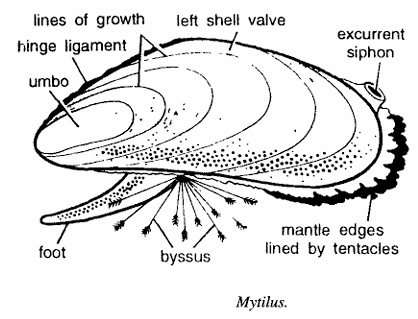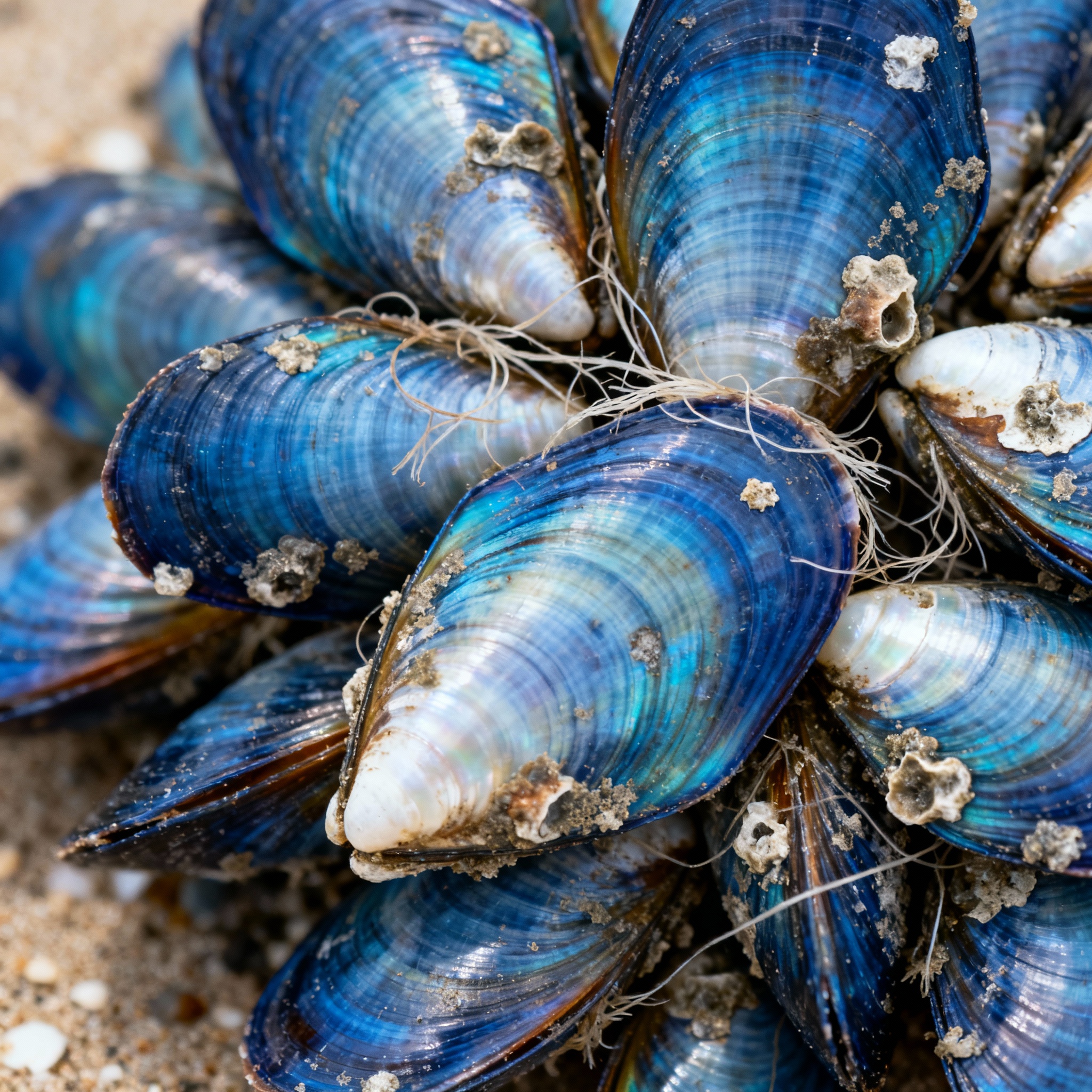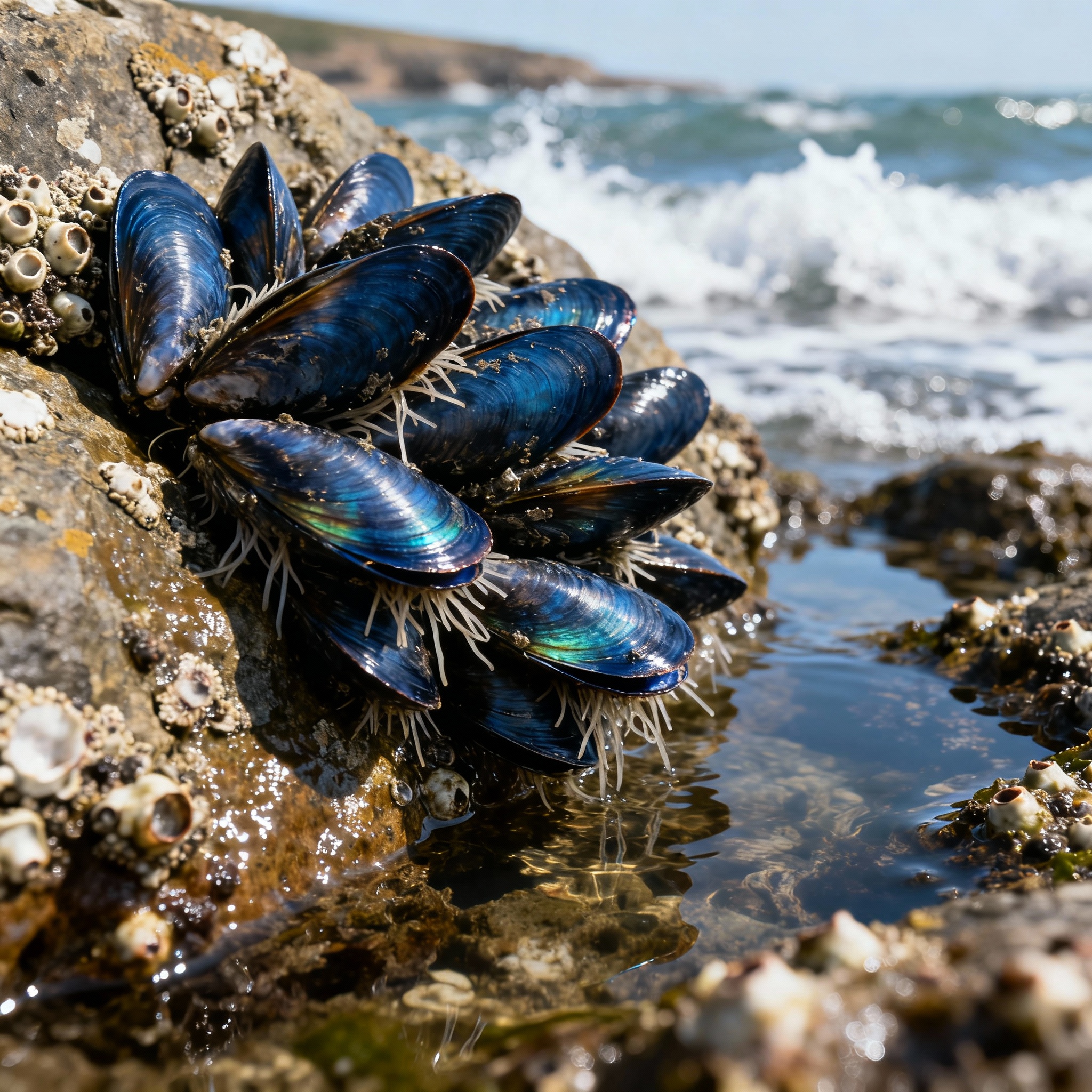Mytilus: Classification, Habitat, Anatomy, Ecology, and Identification
The genus Mytilus encompasses medium to large saltwater mussels, renowned bivalve mollusks of the family Mytilidae and key ecological engineers of temperate marine coasts. These mussels are notable for forming dense beds along rocky shorelines and estuaries, providing habitat structure and stabilizing substrates. Some species such as M. edulis (blue mussel), M. galloprovincialis (Mediterranean mussel), and M. trossulus (Baltic mussel) are also commercially valuable as food and contribute significantly to global aquaculture industries. Mytilus species are cosmopolitan, adaptive, and integral to marine ecosystem health and coastal fisheries.
Classification of Mytilus
| Rank | Taxon | Diagnostic Characteristic |
|---|---|---|
| Domain | Eukaryota | Nucleated, membrane-bound cells |
| Kingdom | Animalia | Multicellular animals, heterotrophic |
| Phylum | Mollusca | Soft-bodied, often shell-bearing |
| Class | Bivalvia | Two-part shell, bilateral, filter-feeding |
| Order | Mytilida | Marine mussels with byssal threads |
| Family | Mytilidae | Elongate, compressed, dark mussels, global coasts |
| Genus | Mytilus | Medium-large, edible, cosmopolitan coast mussels |

Habit and Habitat
Sea mussels live primarily in the intertidal and shallow subtidal zones on rocky substrates, sandbanks, kelp forests, and mussel beds from the Arctic to the southern temperate coasts. They colonize surfaces with byssal threads, forming dense aggregations that stabilize sediment and provide habitat for diverse marine organisms. Mytilus beds shelter juvenile fishes, invertebrates, and algae, playing a foundational role in coastal food webs. Their tolerance for a broad range of salinities, temperatures, and wave exposures makes them successful colonizers and ecological indicators.
Geographical Distribution
The genus is globally distributed, dominated by several lineages:
- Mytilus edulis: North Atlantic (Europe, eastern North America), Arctic regions, Iceland, and introduced to some southern hemisphere coasts.
- Mytilus galloprovincialis: Mediterranean Sea, European Atlantic, parts of the North Pacific, South Africa, Australia, and Asia via introduction.
- Mytilus trossulus: Northern Pacific (America and Asia), Baltic Sea, North Atlantic margins.
- Mytilus californianus: West coast of North America.
- Other species and hybrids occur, with overlap and interbreeding in many regions.
This genus exhibits extensive genetic mixing where distributions overlap, sometimes forming hybrid swarms of ecological interest.

General Characteristics
- Commonly called as sea mussel.
- Shell is elongated equivalved with umbo and marked by lines of growth.
- Hinge toothless but may bear crenulations.
- Postero-ventrally papillated edges of mantle and postero-dorsally lamelliform gills are seen.
- Foot cylindrical with byssus. Postero-ventrally papillated edges of mantle are seen and posterc-dorsally is exhalent siphon.
- Shell is marked with lines of growth.
- Byssal filaments found in a byssal cavity are formed by byssal gland or byssogenous apparatus.
- After removing the shell internal structures such as lamelliform gills, foot, kidney, heart and alimentary canal enclosed by mantle lobes arc visible.
- Gills are lamelliform, i.e., the filaments are plate-like and united by ciliary junctions.
- Anterior adductor muscle is smaller and posterior adductor is larger, i.e., it is heteromyrian form.
- Posterior muscle is large and anterior small (anisomyrian). Sexes are separate. Gonads extend into the mantle. Economic importance: Used for food in Europe. In India also they are relished as food by poor people living at seacoasts.
- Shell Morphology: Equivalve, inequilateral, roughly triangular shells 5–20 cm long. External color is typically dark blue, black, or brown; smooth with concentric growth lines, lacking radial ribs.
- Byssus: Mussels attach permanently to rocks or each other by tough, protein-rich byssal threads secreted by a specialized foot gland.
- Internal Features: Shell interior is blue-purple at the edge, mostly white; strong adductor muscles close the shell.
- Feeding: Mytilus are active suspension feeders, filtering bacteria, phytoplankton, detritus, and dissolved organic matter from water via paired siphons and gill cilia.
- Growth and Life History: Rapid growth rates, maturing at 1–2 years, with adults living up to 15 years. High reproductive output: females spawn millions of eggs per year.
- Mobility: Adults are largely sessile, young spat may relocate by producing temporary threads.
- Group Living: Highly gregarious, forming multi-layered beds up to several meters thick.
Special Features
- Ecological Importance: Dense mussel beds prevent erosion, stabilize substrates, and promote biodiversity as “ecosystem engineers”.
- Resilience: Exceptional tolerance to desiccation, temperature extremes, and water pollution compared to many marine invertebrates.
- Hybridization: Mytilus “complexes” form zones of interbreeding; distinguishing species often requires genetic or molecular methods.
- Economic Value: Harvested wild and farmed for food, shell, and bioproducts; blue mussel fisheries are prominent in Europe, North America, Mediterranean, and Asia.
- Environmental Indicator: Used in biomonitoring of contaminants (metals, microplastics, organics).

Identification
Key features for identifying Mytilus species include:
- Shell Shape: Elongated, triangular, and compressed; smooth external surface, concentric lines, occasionally with variable color and pattern in juveniles.
- Umbones: Terminal and rounded, not sharply pointed.
- Byssal Attachment: Strong bundles visible at shell base.
- Internal Color: Pink, violet, or blue margin, lustrous white center.
- Adductor Scars: Large posterior scar, reduced anterior scar.
- Habitat Preference: Dense clusters on rocks, wharves, piers, kelp, and natural reefs; often intermixed with other Mytilus species.
- Molecular Distinction: DNA sequencing is often required in mixed beds, as shell morphology overlaps; local experts use mantle coloration or shell curvature differences.
References
- https://en.wikipedia.org/wiki/Mytilu_(bivalve)
- https://www.sciencedirect.com/topics/agricultural-and-biological-sciences/mytilus-genus
- https://simple.wikipedia.org/wiki/Mytilus_(genus)
- https://animaldiversity.org/accounts/Mytilus_edulis/
- https://www.marlin.ac.uk/species/detail/1421
- https://www.frontiersin.org/journals/marine-science/articles/10.3389/fmars.2023.1146527/full
- https://www.fisheries.noaa.gov/species/blue-mussel
- https://pmc.ncbi.nlm.nih.gov/articles/PMC5192891/
- https://www.britannica.com/animal/bivalve
- https://www.sciencedirect.com/topics/agricultural-and-biological-sciences/mytilus-edulis
- http://www.marinespecies.org/aphia.php?p=taxdetails&id=138228
- https://academic.oup.com/mollus/article/78/1/66/1101871
- https://www.sciencedirect.com/topics/agricultural-and-biological-sciences/mytilidae
- https://www.fao.org/fishery/docs/CDrom/aquaculture/I1129m/file/en/.!52507!en_bluemussel.htm
- https://www.sealifebase.se/summary/M-galloprovincialis.html
- https://www.sciencedirect.com/science/article/abs/pii/S0022098106005223
